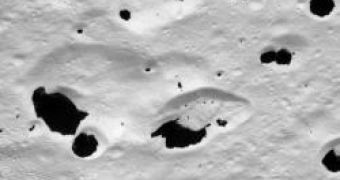The mystery of the space Dalmatian has been solved. The mysterious dark spots on Saturn's moon Iapetus are caused by the Sun. New images delivered by the Cassini spacecraft show the stains are located mainly on the sunward-facing slopes of craters and mountains, pointing to a runaway energy splotching areas of the moon.
The 1470-km (918 mi)-wide Iapetus has a black face and a bright back. The dark, organic-rich material on the satellite's face probably originates from another moon of Saturn and spreads on Iapetus' leading hemisphere like insects crashed on a car's windshield.
As dark material absorbs more sunlight, this side of the moon has become slightly warmer than its back. In time, this induced the evaporation of thin ice sheets, exposing even more dark material embedded in the ice.
The result: a distinctive Dalmatian coat on the satellite's surface. This theory has got a powerful support from the latest Cassini images, achieved during the spacecraft's close flyby of Iapetus on 10 September, 2007.
"We got a very much better look at the relation between the black material and the ice," said Carolyn Porco, leader of Cassini's imaging team.
The researchers detected sharp-edged dark spots covering the whole surface of Iapetus, including the moon's bright trailing hemisphere. Detailed investigation showed that these isolated splotches are preferentially distributed on the craters' slopes facing the Sun, pointing that as the slopes slightly heat up, ice begins to evaporate, exposing more dark material contained in the ice, which further increases the amount of absorbed solar heat.
"It's a runaway process," Porco told New Scientist.
But the thermal segregation doesn't solve any mystery about the precise nature of the dark material. Some of the dark material seems to have penetrated the ice long time ago, while other materials could have entered Iapetus more recently.
"The presence of dark material on some crater floors suggests that some dark material may have slid down the slopes of the craters. We certainly don't know all the details yet," said Porco.

 14 DAY TRIAL //
14 DAY TRIAL //